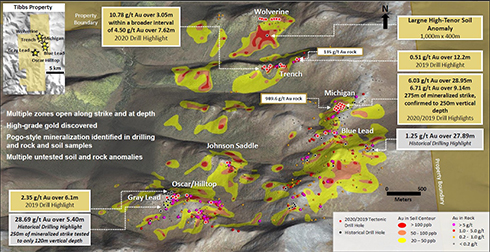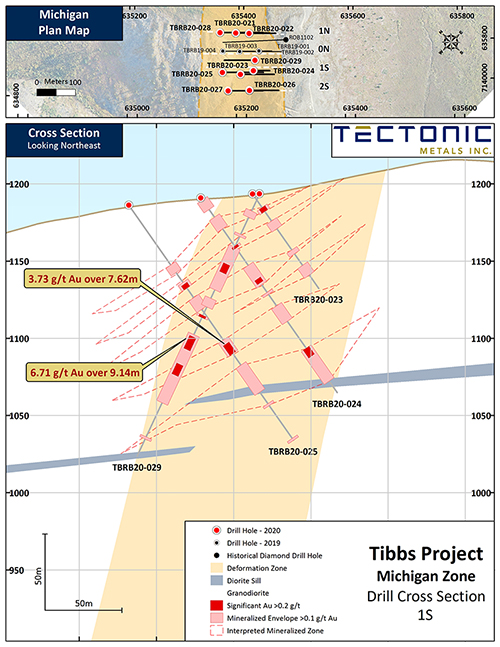I agree to and consent to receive news, updates, and other communications by way of commercial electronic messages (including email) from Tectonic metals. I understand I may withdraw consent at any time by clicking the unsubscribe link contained in all emails from Tectonic metals.
Geological Summary
The Tibbs property is located within the Yukon-Tanana terrane (YTT), an allochthonous accreted terrane comprised mainly of Proterozoic to Triassic metaigneous and metasedimentary assemblages extending from east-central Alaska to south-central Yukon. The YTT is bounded to the north by the Tintina Fault Zone and to the south by the Denali Fault; both show a lateral displacement of roughly 400 km. Conjugate to these are a series of northeast-trending faults, including the Shaw Creek fault directly west of the Pogo deposit, and the Black Mountain Tectonic Zone which extends through the Tibbs property area. District-scale northwest-trending sympathetic faults, including the Pogo trend, occur between the Tintina and Denali faults. The YTT east of the Black Mountain fault has undergone intrusion by Cretaceous to Tertiary plutonic rocks, including the Black Mountain intrusion.
The Black Mountain tectonic zone is centered along the western boundary of the mid-Cretaceous Black Mountain intrusion, in contact with Devonian biotite gneiss and augen gneiss to the west. In the property area, the Black Mountain tectonic zone occurs as a series of northeast to north-northeast trending normal and left-lateral high-angle strike-slip faults. The Black Mountain intrusion is comprised of biotite granodiorite with lesser andesite porphyry. A late biotite-hornblende diorite dyke crosscuts all units, and marks much of the west margin of the intrusion.
Three styles of gold mineralization have been observed at the project: Pogo-style Au+Bi±As±Te±W in quartz veins at the Gray Lead and Hilltop/Oscar prospects, and Au+As+Sb in quartz veins and wall rock disseminations at the Michigan, Blue Lead, Grizzly Bear, Upper/Lower Trench, O’Reely, and Wolverine prospects. Several of these prospects host both styles of mineralization in the same structure suggesting multi-phase mineralization took place. At the Gray Lead prospect a quartz-arsenopyrite ± pyrite ± bismuthinite ± jamesonite vein attaining widths of up to 4 metres was formed at temperatures from 260 – 455 °C, and pressures of not less than 1,700 bar. The vein appears to extend roughly along the western contact of the Black Mountain intrusion at the Gray Lead prospect. In the east of the project, quartz-stibnite-arsenopyrite veins and stockworks are found within sericitized granodiorite, notably at the > 1 km long, northeast trending corridor which defines the Michigan prospect. Both styles of mineralization are believed to represent a single intrusion-related gold system, with a deeper, higher-pressure setting for Gray Lead-style mineralization, and a higher-level, lower pressure, outboard setting for mineralization at Michigan. Prospecting activity during the summer of 2020 identified a third style of mineralization at Tibbs in the form of Fort Knox-style intrusion-hosted sheeted gold-quartz-bismuthenite veins at the Jorts and Hilltop prospects.
Maps
View +

Drill Results
2021 Drill Results
Tibbs Project - 2021 Phase I Drill Assay Sheets
Tibbs Project - 2021 Phase II Drilling Highlights
Tibbs Project - 2021 Phase II Drill Collar Information
Tibbs Project - 2021 Phase I Drill Assay Sheets
Tibbs Project - 2021 Phase I Drilling Highlights
Tibbs Project - 2021 Phase I Drill Collar Information
2020 Drill Results
Tibbs Project – 2020 RAB Drill Assay Sheets
Tibbs Project – 2020 Rotary Air Blast (“RAB”) Drill Results
Tibbs Project – 2020 RAB Drill Collar Information
2019 Drill Results

